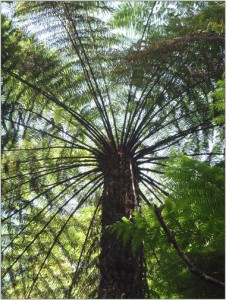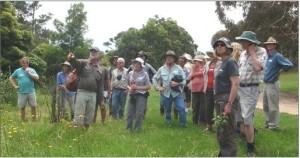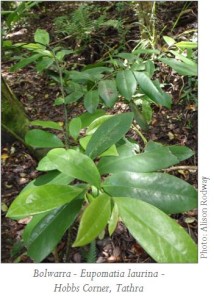 Vegetable dinosaurs are alive and well in the deepest, shadiest gullies of our local rainforests. Why does the Bolwarra, a dinosaur of the plant world, live in this part of the landscape? Local botanist Stuart Cameron explains this and more in a short version of his talk at the Tathra plant identification field day, held in December 2010.
Vegetable dinosaurs are alive and well in the deepest, shadiest gullies of our local rainforests. Why does the Bolwarra, a dinosaur of the plant world, live in this part of the landscape? Local botanist Stuart Cameron explains this and more in a short version of his talk at the Tathra plant identification field day, held in December 2010.
Although identifying and naming a plant is an essential first step, the truly fascinating part of the process begins when one explores why a particular plant is here, why it is not over there – when one begins to read the landscape.
To do this accurately you must first determine and take account of your location – geographical, geological and historical.
In the South East corner of Australia certain climate conditions prescribe the limits of distributions: rainfall levels and reliability, the frequency and severity of frosts, the length of the growing season.
A significant number of our species are at their northern or southern limits at or near Tathra. Spotted gums, burrawangs, and rusty figs are at their southern limit; Bootlace bush, climbing lignam (Muehlenbeckia adpressa) and the daisy bush Ozothamnus turbinatus are at their northern limit.
 Geology is absolutely fundamental to botany. It determines the availability of moisture and nutrients, as well as the forms and stability of the landscape. Whether it is flat, waterlogged, dry, steep, fire-protected, fire-prone, frequently disturbed or stable and so on.
Geology is absolutely fundamental to botany. It determines the availability of moisture and nutrients, as well as the forms and stability of the landscape. Whether it is flat, waterlogged, dry, steep, fire-protected, fire-prone, frequently disturbed or stable and so on.
A significant geological boundary passes through Tathra at Hobbs corner. To the south are volcanic rocks which extend south to Bournda. To the north the substrate is the Ordovician sedimentary rock which outcrops spectacularly in the cliffs at Mogareeka. This boundary has botanical implications. The volcanic rocks support impressive specimens of the rusty fig (Ficus rubiginosa; Melaleuca armillaris dominates the volcanic sea cliffs, while eucalypts and casuarinas are prominent on the Ordovician outcrops.
On the highly disturbed beach strand, storms periodically sweep away the entire habitat, and seeds arrive in a lottery distributed by winds, currents and waves. Near the shore salt influence is very strong, exposure to sun and wind extreme, and soil organic content very low. Moving inland all these conditions ameliorate and the vegetation changes accordingly.
Back from the beach a new powerful factor becomes dominant: fire. Australian vegetation can be divided into two broad categories distinguished by their relation to fire – whether plants are adapted to it, have devised ways to survive and even utilise it or, on the other hand, whether its influence is purely destructive.
Those plants on which fire impact is overwhelmingly negative are called rainforest plants, which is rather a misnomer. These are the plants found where the fire influence is absent or attenuated – wet places, deep fire-protected gullies, tracts of land protected by water bodies, marshes or cliffs. Where fire protection is afforded in close proximity to the sea a community blending coastal and rainforest species can form – littoral rainforest.
To understand the nature and composition of rainforest we need to position ourselves in deep, geological time. We are sliding inexorably northwards on a vast chunk of continental crust that is a fragment of the lost supercontinent of Gondwana, which in its heyday made up the greater part of the Earth’s land surface.
 As Australia has drifted north it has become steadily hotter, drier, more prone to climatic swings and much more fiery. The oldest, least changed species are in those sites best able to resist these trends. These sites form an archipelago of refugia scattered up the east coast.
As Australia has drifted north it has become steadily hotter, drier, more prone to climatic swings and much more fiery. The oldest, least changed species are in those sites best able to resist these trends. These sites form an archipelago of refugia scattered up the east coast.
Some rainforests in Australia have remained sufficiently unchanged to support flowering plant species considered to be among the most primitive still surviving – for example Bolwarra (Eupomatia laurina), a vegetable dinosaur, is still common in our deepest, shadiest gullies.
Beyond the rainforest refugia the original rainforest genetic stock evolved into species able to deal with the new conditions – the most characteristic Australian plants: the eucalypts, wattles, peas, daisies and grasses. These are encountered on the dry ridges above the rainforest gullies.
We are living in an interglacial, a geologically brief warm spell in midst an ice age. During an ice age ice caps form near the poles; they expand and contract with great rapidity and climatic zones ricochet between the equator and the poles. Huge pressures are placed on vegetation, not least because sea levels are in constant flux. The coast here is an ephemeral thing, in a century it is likely to be much further inland, 15 thousand years ago it was well off shore. What we see around us is vegetation responding to extreme and rapid climate oscillations.
To read the landscape we need to take account not only of deep geological time but also of human historical time. Aboriginal people have had a major impact on our landscapes by greatly increasing the frequency of fires and thus advantaging the fire-tolerant species. The impact of European settlers on our landscapes has been vastly greater – both the subtraction by clearing and the addition of hundreds of exotic species from all round the world.
Everything we see today is to some extent human-modified. Every plant on the planet is affected by human-induced changes to the atmosphere, especially rising CO2 levels and the associated rise in temperatures.
In order to interpret and take account of human impact we need to look for signs such as cut stumps, fire scars, old fence posts, exotic species. It may well be that what we are seeing is a vegetation community restoring itself after a major human disturbance with a disproportionate representation of gap species and an absence of species which do not readily recolonise.
With all this in mind it becomes possible to begin a reading of the Tathra landscape.



